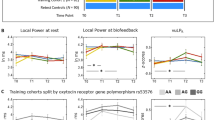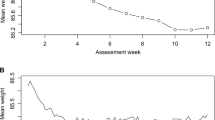Abstract
Childhood obesity is a major public health concern; behavioural interventions induce weight reduction in some, but success is variable. Heart rate variability (HRV) has been associated with impulse control and extent of dieting success. This study investigated the relationship between HRV and post childhood obesity intervention weight-management success, and involved recording the frequency-domain HRV measures ratio between low frequency and high frequency power (LF/HF) and high frequency power (HF), and the time-domain measure, percentage of successive beat-to-beat intervals that differ by more than 50ms (PNN50). It was expected that greater LF/HF and lower HF would be associated with greater post-intervention weight gain, and that greater PNN50 would be associated with greater impulse control. Seventy-four participants aged 9–14 (M=10.7; s.d.: 1.1) attended a weight-management camp, where HRV was recorded. Stop signal reaction time (SSRT) was also recorded as a measure of impulse control. As expected, SSRT was positively associated with pre-intervention body mass (r=0.301, P=0.010) and negatively associated with PNN50 (β=0.29, P=0.031). Post-intervention body mass change was positively associated with LF/HF (β=0.34, P=0.037), but was not associated with HF. Lifestyle interventions may have a greater chance of effectively supporting long-term weight-management for children with lower LF/HF; assessing HRV of obese children may be helpful in informing obesity treatment decisions.
This is a preview of subscription content, access via your institution
Access options
Subscribe to this journal
Receive 12 print issues and online access
$259.00 per year
only $21.58 per issue
Buy this article
- Purchase on Springer Link
- Instant access to full article PDF
Prices may be subject to local taxes which are calculated during checkout
Similar content being viewed by others
References
Ng M, Fleming T, Robinson M, Thomson B, Graetz N, Margono C et al. Global, regional, and national prevalence of overweight and obesity in children and adults during 1980–2013: a systematic analysis for the Global Burden of Disease Study 2013. Lancet 2014; 384: 766–781.
Daniels S . Complications of obesity in children and adolescents. Int J Obes 2009; 33: S60–S65.
Oude Luttikhuis H, Baur L, Jansen H, Shrewsbury VA, O'Malley C, Stolk RP et al. Interventions for treating obesity in children. Cochrane Database Syst Rev 2009; CD001872.
Gately PJ . Residential Weight Loss Camps for Children and Young People. In: Haslam DW, Sharma AM, Le Roux CW (eds). Controversies in Obesity. Springer-Verlag: London, UK, 2014, pp 221–227.
Taylor MJ, Arriscado D, Vlaev I, Taylor D, Gately P, Darzi A . Measuring perceived exercise capability and investigating its relationship with childhood obesity: a feasibility study. Int J Obes 2016; 40: 34–38.
Gately PJ, Cooke CB, Butterly RJ, Mackreth P, Carroll S . The effects of a children's summer camp programme on weight loss, with a 10 month follow-up. Int J Obes 2000; 24: 1445–1452.
Nederkoorn C, Braet C, Van Eijs Y, Tanghe A, Jansen A . Why obese children cannot resist food: the role of impulsivity. Eat Behav 2006; 7: 315–322.
Schag K, Schönleber J, Teufel M, Zipfel S, Giel K . Food‐related impulsivity in obesity and Binge Eating Disorder–a systematic review. Obes Rev 2013; 14: 477–495.
Kulendran M, Vlaev I, Sugden C, King D, Ashrafian H, Gately P et al. Neuropsychological assessment as a predictor of weight loss in obese adolescents. Int J Obes 2014; 38: 507–512.
Thamotharan S, Lange K, Zale EL, Huffhines L, Fields S . The role of impulsivity in pediatric obesity and weight status: a meta-analytic review. Clin Psychol Rev 2013; 33: 253–262.
Hjördis B, Gunnar E, Daisy S . Personality traits related to eating behavior and weight loss in a group of severely obese patients. Int J Eat Disord 1989; 8: 315–323.
Meule A, Lutz A, Vögele C, Kübler A . Self-reported dieting success is associated with cardiac autonomic regulation in current dieters. Appetite 2012; 59: 494–498.
Booij L, Swenne CA, Brosschot JF, Haffmans PJ, Thayer JF, Van der Does AW . Tryptophan depletion affects heart rate variability and impulsivity in remitted depressed patients with a history of suicidal ideation. Biol Psychiatry 2006; 60: 507–514.
Ingjaldsson JT, Laberg JC, Thayer JF . Reduced heart rate variability in chronic alcohol abuse: relationship with negative mood, chronic thought suppression, and compulsive drinking. Biol Psychiatry 2003; 54: 1427–1436.
Geisler F, Kubiak T . Heart rate variability predicts self‐control in goal pursuit. Eur J Personality 2009; 23: 623–633.
Thayer JF, Hansen AL, Saus-Rose E, Johnsen BH . Heart rate variability, prefrontal neural function, and cognitive performance: the neurovisceral integration perspective on self-regulation, adaptation, and health. Ann Behav Medi 2009; 37: 141–153.
Task Force of the European Society of Cardiology. Heart rate variability standards of measurement, physiological interpretation, and clinical use. Eur Heart J 1996; 17: 354–381.
Thayer JF, Lane RD . Claude Bernard and the heart–brain connection: further elaboration of a model of neurovisceral integration. Neurosci Biobehav Rev 2009; 33: 81–88.
Mazurak N, Enck P, Muth E, Teufel M, Zipfel S . Heart rate variability as a measure of cardiac autonomic function in anorexia nervosa: a review of the literature. Eur Eat Disord Rev 2011; 19: 87–99.
Latchman PL, Mathur M, Bartels MN, Axtell RS, De Meersman RE . Impaired autonomic function in normotensive obese children. Clin Auton Res 2011; 21: 319–323.
Meule A, Vögele C, Kübler A . Restrained eating is related to accelerated reaction to high caloric foods and cardiac autonomic dysregulation. Appetite 2012; 58: 638–644.
Public Health England. International Obesity Taskforce 2013. Available at http://www.sepho.org.uk/viewResource.aspx?id=13022 (accessed on 19 December 2015).
Freeman J, Cole T, Chinn S, Jones P, White E, Preece M . Cross sectional stature and weight reference curves for the UK, 1990. Arch Dis Child 1995; 73: 17–24.
Altini M . Heart rate variability logger - app details 2013 [cited 2016 2 May]. Available at https://itunes.apple.com/us/app/heart-rate-variability-logger/id683984776?ls=1&mt=8 (accessed on 19 December 2015).
Schachar R, Logan GD . Impulsivity and inhibitory control in normal development and childhood psychopathology. Dev Psychol 1990; 26: 710.
Logan GD, Cowan WB, Davis KA . On the ability to inhibit simple and choice reaction time responses: a model and a method. J Exp Psychol Hum Percept Perform 1984; 10: 276.
Lipszyc J, Schachar R . Inhibitory control and psychopathology: a meta-analysis of studies using the stop signal task. J Int Neuropsychol Soc 2010; 16: 1064–1076.
Koenig J, Jarczok M, Warth M, Ellis R, Bach C, Hillecke T et al. Body mass index is related to autonomic nervous system activity as measured by heart rate variability—a replication using short term measurements. J Nutr Health Aging 2014; 18: 300–302.
Logan GD, Schachar RJ, Tannock R . Impulsivity and inhibitory control. Psychol Sci 1997; 8: 60–64.
Billman G . The LF/HF ratio does not accurately measure cardiac sympatho-vagal balance. Front Physiol 2012; 4: 26.
Shaffer F, McCraty R, Zerr CL . A healthy heart is not a metronome: an integrative review of the heart's anatomy and heart rate variability. Front Psychol 2014; 5: 1040.
Malliani A, Lombardi F, Pagani M . Power spectrum analysis of heart rate variability: a tool to explore neural regulatory mechanisms. Br Heart J 1994; 71: 1.
Berntson GG, Cacioppo JT . Heart rate variability: a neuroscientific perspective for further studies. Cardiac Electrophysiol Rev 1999; 3: 279–282.
Ishida R, Okada M . Effects of a firm purpose in life on anxiety and sympathetic nervous activity caused by emotional stress: assessment by psycho‐physiological method. Stress Health 2006; 22: 275–281.
Taylor SE . Tend and befriend biobehavioral bases of affiliation under stress. Curr Direct Psychol Sci 2006; 15: 273–277.
Krygier JR, Heathers JA, Shahrestani S, Abbott M, Gross JJ, Kemp AH . Mindfulness meditation, well-being, and heart rate variability: a preliminary investigation into the impact of intensive Vipassana meditation. Int J Psychophysiol 2013; 89: 305–313.
Acknowledgements
This research was made possible by NPRP grant No. NPRP X-036-3-013 from the Qatar National Research Fund (a member of Qatar Foundation). The authors are grateful to all participating schools and children. The authors are also grateful to Ms Jackie Lothian and Ms Sahar Karim Jreige for their assistance with the data collection, and to Dr Francis Kynaston-Pearson and Dr Simon Taylor for their comments and suggestions in relation to manuscript drafts.
Disclaimer
This statements made herein are solely the responsibility of the authors.
Author information
Authors and Affiliations
Corresponding author
Ethics declarations
Competing interests
Professor Paul Gately is a Professor at Leeds Beckett University as well as being the Managing Director and a shareholder of MoreLife UK Ltd. MoreLife UK Ltd is an organisation that delivers weight management and health improvement programmes in the UK, it is a subsidiary company of Leeds Beckett University. The remaining authors declare no conflict of interest.
Rights and permissions
About this article
Cite this article
Taylor, M., Vlaev, I., Taylor, D. et al. Cardiac autonomic regulation as a predictor for childhood obesity intervention success. Int J Obes 41, 824–827 (2017). https://doi.org/10.1038/ijo.2017.25
Received:
Revised:
Accepted:
Published:
Issue Date:
DOI: https://doi.org/10.1038/ijo.2017.25



